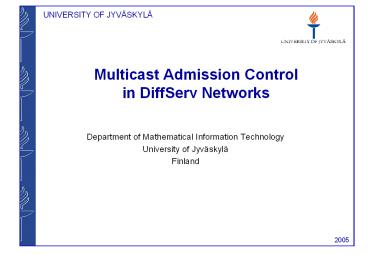Multicast%20Admission%20Control%20in%20DiffServ%20Networks - PowerPoint PPT Presentation
Title:
Multicast%20Admission%20Control%20in%20DiffServ%20Networks
Description:
IPTV, video conferences, etc. are more and more transferred in the IP networks ... FTP, IPTV and video conference were used as the applications ... – PowerPoint PPT presentation
Number of Views:24
Avg rating:3.0/5.0
Title: Multicast%20Admission%20Control%20in%20DiffServ%20Networks
1
Multicast Admission Control in DiffServ Networks
- Department of Mathematical Information Technology
- University of Jyväskylä
- Finland
2
Introduction
- IPTV, video conferences, etc. are more and more
transferred in the IP networks nowadays than
earlier - Video services demand strict QoS limits in terms
of delay, jitter and packet loss - Multicast is a relevant transmission mechanism
for these services - Differentiated Services is likely to be the most
used QoS architecture in future
3
The Methods
- There are three different admission control
methods Measurement based 12 and Parameter
based - The methods are distributed to the edge nodes
- Based on filtering the join requests from
customers - The admission control methods are divided into
three distinct phases
4
Phase 1 Edge test
- Is common for all the methods
- If the edge router that receives the join request
already is forwarding the particular group, the
join is automatically accepted - Otherwise, the method moves to the phase 2 before
making any decisions
5
Phase 2 Bandwidth test (1/2)
- Measurement based methods 1 2
- Measurement 1 inspects if there is enough room on
the links for the new receiver - Measurement 2, on the other hand, inspects if
there is room within the class on every link - Based on MGRIP protocol
- Checks only the path between egress edge node and
branching node - Only the links whose utilization would increase
are inspected
6
Phase 2 Bandwidth test (2/2)
- Parameter based method
- The available bandwidth is aproximated using the
following equation - Other assumptions are the same than with
measurement based methods 1 2
7
Phase 3 Measurement test (1/2)
- Methods Measurement 1 and 2
- Egress edge joins the group, receives n first
packets and calculates loss, delay and jitter for
the packets - Exponential average of current and history
results is used to compare against defined limits - Uses packets RTP headers to calculate QoS
parameters
8
Phase 3 Measurement test (2/2)
- Parameter based method
- The maximum end-to-end delay, that can occur on
the path, is approximated using the following
equation - In our simulation environment, every node tracks
the number of active connections it is forwarding
9
Simulations
- Simulations were done with Network Simulator 2
- Traffic of two customers was measured and other
customers produced the background traffic - FTP, IPTV and video conference were used as the
applications - Video traffic was produced from real captured
video stream
10
Simulation topology
11
Results
- Tens of identical simulations with different
background traffic loads were ran - First case shows a situation in a slightly loaded
network - Second case shows a situation with more loaded
network - The last case presents the influence of backgroud
traffic
12
Results
- Low utilization Throughput
13
Results
- High utilization Delay
14
Results
- High utilization Loss
15
Results
- High utilization Throughput
16
Results
- Background traffics effect on throughput
17
Results
- Background traffics effect on delay
18
Results
- Background traffics effect on loss
19
Conclusions based on simulations
- The need for admission control can be seen
clearly - Our simple admission control method gives better
quality for the customers being served - Decreased throughput and rejection of some of the
requests is the cost of the method
20
ADC implementation
- Linux workstation with more than 1 NIC as a Edge
router - XORP is an open source IP router platform which
is used to perform the router functionality - Unix IPtables is used to filter the packets
needed for admission control decisions and
measuring purposes - ADC implementation performs packet loss, jitter
and delay calculations which it uses for decision
making - Next, a multicast receiver implementations will
be done to easily measure the quality of service
experienced by the receivers
21
ADC network topology
22
- The end































